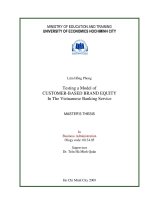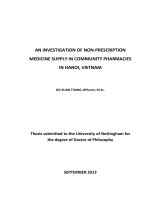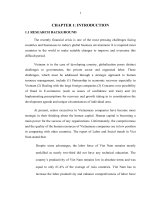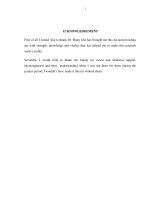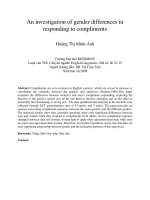FACTORS AFFECTING JOB PERFORMANCE AN INVESTIGATION OF EMPLOYEES IN THE VIETNAMESE BANKING INDUSTRY
Bạn đang xem bản rút gọn của tài liệu. Xem và tải ngay bản đầy đủ của tài liệu tại đây (520.61 KB, 69 trang )
1
CHAPTER 1: INTRODUCTION
1.1 RESEARCH BACKGROUND
The recently financial crisis is one of the most pressing challenges facing
countries and businesses in today's global business environment. It is required most
countries in the world to make suitable changes to improve and overcome this
difficult period.
Vietnam is in the case of developing country, globalization poses distinct
challenges to governments, the private sector and organized labor. These
challenges, which must be addressed through a strategic approach to human
resource management, include (1) Partnership in economic recovery especially in
Vietnam (2) Dealing with the large foreign companies (3) Concerns over possibility
of fraud in E-commerce (such as issues of confidence and trust) and (4)
Implementing prescriptions for recovery and growth taking in to consideration the
development agenda and unique circumstances of individual area.
At present, senior executives in Vietnamese companies have become more
strategic in their thinking about the human capital. Human capital is becoming a
main power for the success of any organizations. Unfortunately, the competiveness
and the quality of the human resources of Vietnamese companies are in low position
in comparing with other countries. The report of Labor and Social trends in Viet
Nam stated that:
Despite some advantages, the labor force of Viet Nam remains mostly
unskilled as nearly two-third did not have any technical education. The
country’s productivity of Viet Nam remains low in absolute terms and was
equal to only 61.4% of the average of Asia countries. Viet Nam has to
increase the labor productivity and enhance competitiveness of labor force
2
if the country desires to move up in regional and global production
networks. In order to reach the goal of the economic growth as well as the
higher quality of labor force, Viet Nam must address many issues,
especially in human resources. (International Labor Organization Report,
2010).
1.2 RESEARCH PROBLEMS
Banking industry is the heart of any economies. Firstly, banks act as
delegated monitors and ensure that firms use the resources allocated to them
effectively. Secondly, banks also play an important role as tool for executing macro
– economic policies. Go along with the quickly changes in business environment,
the banking industry has renewed itself to catch up with the requirements of bank’s
users. Almost banks are offering many kinds of valuable services for customers
besides its traditional services in order to upgrade the satisfaction of the bank’s
customers. Consequently, beyond the normal expectation of providing excellent
customer service, the bank’s employees are also required to sell various added value
services.
The quality of banking services has been moved on strongly improvement
over the last few years, it is still in its infancy. The old banking systems and the old
habit of local Vietnamese resident were two major obstacles to access to finance for
Vietnam’s large population of bankable but under-banked households and
enterprises. In the future, the Vietnamese banks have to do their businesses in
competitive environment not only with local banks but also with a lot of foreign –
owned banks. The banks need employees with high knowledge to advise more
suitable services for their customers and attract more customers to use more
services of banks. (See more information about Vietnamese Banking Industry in
Appendix A)
3
Among many industries, banking industry is one of the most industry has the
fastest growth in the human resources in both quantity and quality. Banking
industry has the highest attraction with job- seekers during the last ten years. The
average growth in human resources of banking industry during the period 2000-
2010 was about 10% each year (Nguyen, 2012). Unfortunately, the demand of
banking employees is forecasted to be in the down –trend in the next few years.
According to the point of view of specialists in banking industry, many banks will
cut off the employees in the next time (at the-end of 2012 and next year 2013)
because of the difficulties of macroeconomic as well as the decrease in the profit of
almost banks. However, the banks will take much caution to increase the quality of
labor force for banking industry. There will be some adjustments in the human
resources policies, especially in training and recruiting human resources. It means
that there will be a called for qualified employees who can help to enhance the
performance of banking industry.
The employee takes a key factor to the bank’s performancce. In order to
enhance the productivity and profitability of the bank, the performance of employee
should be strongly considered. It is important for bank’s managers to understand
and to investigate whether their employees are satisfied with their job or not. Only if
they are satisfied, they will work with strong commitment, with high effort and
perform their best. By this way, employees will project a positive image of the
organization as well as improve their performance and the bank’s performance.
As forementionded reasons, it is necessary for bank’s managers to
investigate which factors affect the job performance of their employees in
Vietnamese banking industry.
Many studies have proved that sustainable competitive advantages can best
be accomplished through context- specific, cumulative, renewable, and thus hard to
imitate factors (Susan., Luthans., Kyle., Sandra., & Richard., 2007). The
comprehensive study (Luthans et al.,2007) have noted that “integrating human,
4
social, and now psychological capital can have great impact on job performance
than any of the previously listed resources in separately”.
Even there were many studies concerning about positive organization
behaviors and its relationship with job performance as well as the relationship
between the working environment and job performance, most of these studies
focused on the West, Mid West and the United States. In Asian region, most studies
concentrated on developed Asian countries (Singapore, China, Taiwan, Malaysia,
etc) than developing countries like Vietnam, Lao, Cambodia. In Viet Nam, there
were many studies related to job satisfaction or job performance but most of these
studies pay much attention to the working environment, leadership styles,
organization commitment than to the Psychological Capital of the employees. The
newest researh related to Psychological Capital, Quality of Working Life, Quality of
Life (Nguyen and Nguyen, 2012). However, the objective of the research is the
marketer in Vietnamese Market. Researching in the field of Psychological Capital
as well as the Quality of Working life in the different industries is in shortage status.
Therefore, the problem to be accessed in this study is to exam the factors that
impact job performance of employees in Vietnamese banking industry, especially
concerning to the Psychological Capital and Quality of Working Life.
1.3 RESEARCH OBJECTIVES
According to Zikmund (1997, p.89), a research objective is the researcher’s
version of a business problem. Objectives explain the purpose of the research in
measurable terms and define standards of what the research should accomplish. In
solving the research problem mentioned previously, this study has the following
objectives:
• Identify factors that affect job performance of employees in the Vietnamese
banking industry, specify to factors that belong to psychological capital and quality
of working life.
5
• Determine the degree of the impact of each factor to job performance of
employees in the Vietnamese banking industry.
Research Questions
Research questions involve the research translation of “problem” into the
need for inquiry. The research problems defined above leads to the following
research questions:
• What are factors that impact on job performance of the employees in the
Vietnamese banking industry?
• What are the effects of self – efficacy, hope, optimism, resiliency, survival
needs, belonging needs and knowledge needs on the job performance of employees
in the Vietnamese banking industry?
1.4 RESEARCH METHODOLOGY AND SCOPES
The object of this study is the employee of banks in Ho Chi Minh City. The
research is conducted in Ho Chi Minh City, one of the biggest economic centers of
Viet Nam. The result of the research in this city, in some level can represent for
Viet Nam in general and be used as reference for further purposes.
The author uses data analyse tool (Microsoft Excel, SPSS) to handle the data
and to implement the study such as: Descriptive Statistics, Graphs. After that, using
the tool to test the scale reliability (Cronbach’s Anpha), Factor Analysis, using
Linear Regression to test the relationship between independents variables and
dependent variable.
The research only approaches into factors concerning in Psychological
Capital, quality of working life with the job performance. The other factors such as:
Personality traits or traits – like characteristics such as found in the Big Five
6
dimensions, Organizational Citizenship Behavior, Organizational Commitment…
will be out of the topic of this research.
1.5 STRUCTURE OF THE RESEARCH
The structure of the study consists five chapters:
Chapter 1: Introduction
This chapter presents research background of the study, as well as, research
problems, research objectives, research methodology and scopes.
Chapter 2: Literature Review and Hypotheses
In this chapter, the author provides the literature review and presents the
fundamental ideas on two main constructs: psychological capital and quality of
working life. Besides, the definition and the literature review of the following
constructs also provided: self- efficacy, hope, optimism, resiliency, survival needs,
belonging needs, knowledge needs. In this chapter, the conceptual model of the
study and the hypotheses of the study are also presented.
Chapter 3: Research Methodology
Based on the research objectives and scopes, research methodology
concerning in chapter 1, and literature review and empirical model presented in
chapter 2, this chapter particularly presents the research design, research
methodology and reports the processes of doing the research.
Chapter 4: Data Analysis and Data Results
Chapter 4 presents the characteristics of research samples and presents the
result of the research after analyzing data. Based on the results, the author will make
deep analysis about each factor that impact on job performance.
7
Chapter 5: Conclusions, Implications and Limitations
Chapter 5 presents main conclusions and implications based on the results of
the previous chapters, as well as the limitations of this study.
8
CHAPTER 2: LITERATURE REVIEW AND HYPOTHESES
In this chapter, the author provides the literature review and presents the
conceptual model and hypotheses of the research.
2.1 POSITIVE PSYCHOLOGICAL CAPITAL
Following the resource – based theory of the firm, organizations can develop
sustained competitive advantage only by developing value creating resources and
capabilities which are rare and difficult for competitors to imitate (Barney, 1995).
Consistent with the resource – based view of the firm, the effective development
and integration of positive psychological capital with other assets can provide an
organization with intangible resource that is valuable, rare and difficult to imitate
and therefore a source of competitive advantage (Jensen, Luthans, Lebsack &
Lebsack, 2007). Luthans (2004) and colleagues have provided some important
constructs in this fields such as: economic capital (“What you have”), human capital
(“What you know”), and social capital (“Who you know”) in order to create value
and maintain their success over time.
Nowadays, most managers would agree that positive psychology is
something they value in employees so that the author investigated literature review
about positive psychology as well as positive organization behavior in this study.
Moreover, the author put more effort to explore the literature to four specific
factors: self – efficacy, optimism, hope, resilience.
“Positive psychology” revisits the ‘average person’ with an interest in
finding out what works, what is right, and what is improving (Sheldon & King,
2001, p.216). Following the lead of positive psychology, positive organizational
behavior has recently been strongly considered. Positive organizational behavior
has been defined as “the study and application of positively oriented human
resource strengths and psychological capacities that can be measured, developed,
9
and effectively managed for performance improvement” (Luthans, 2002b, p. 59;
also see Nelson & Cooper, 2007; Turner, Barling, & Zaharatos, 2002; Wright,
2003).
Drawing from positive psychology and positive organizational behavior and
in particular the notion of psychological capital, Luthans (2004) and collogues
suggest that “identifying and developing the positive psychological capacities of
individuals may lead to desirable performance outcomes”. We have a strong believe
that the positive psychological strengths might be especially relevant for
organizations competing in the dynamic and increasingly competitive banking
industry.
To date, the psychological capacities associated with positive organizational
behavior include hope, resilience, optimism, and self-efficacy, and when combined
together, represent for the higher order core factor for “Psychological Capital”.
(Luthans & Youssef, 2004; Luthans et al. 2007).
PysCap as a State-like Construct:
It is important to pay attention that PsyCap and its constructs as found in the
positive psychological literature rather than just a fixed trait. Athough positive trait
and states do share some common correlates and related outcomes), recent theory –
building and empirical research also support their distinctiveness and discriminatnt
validity (Avey et al.,2008).
In most studies, the authors pay attention to the PsyCap as state-like and base
on the positive psychological literature which relevant to positive organizational
behavior.
PsyCap’s foundation also drawn from social cognitive theory (Bandura,
1997), which establishes reciprocal interactions9 between person, the environment,
and past behavior However, in the recently theory, the PsyCap can be defined as:
10
An individual’s positive pyschological state of development that is
characterized by: (1) having confidence (self-efficacy) to take on and put in
the necessary effort to succed at challenging tasks; (2) making a positive
attribution (optimism) about succeeding now and in the future; (3)
perserving towards goals and, when necessary, redirecting paths to goals
(hope) in order to succeed; and (4) when beset by problems and adversity,
sustaining and bouncing back and even beyond (resiliency) to attain
success. (Luthans, Youssef, and Avolio 2007,3).
As mentioned above, the integration of hope, efficacy, resilience and
optimism represents the core construct of Psychological Capital or PsyCap. In
previous studies, Pyscap has a relatively stronger relationship to their performance
than each of individual facets of hope, resilience, optimism, and self – efficacy.
However, the purpose of this study is to analyze how hope, resilience, optimism,
and efficacy individually impact on the job performance. Hence, the literature
review of each facet should be deeply investigated.
Most previous studies on hope, resilience, optimism, and efficacy have
supported that they are in high considerable. Bandura (1997) has demonstrated
strategies to increase self-efficacy (also see Bandura, 2000), Snyder (2000) provides
evidence that hope is developable and published the state–hope scale (Snyder et al.,
1996). Carver and Scheier (2005) more recently discuss strategies to develop
optimism, and Shifren and Hooker (1995) have demonstrated its situational
measurement. Seligman (1998) features “learned optimism” in his widely
recognized book by this title and offers evidence to support its development. Masten
and Reed (2002) likewise discuss successful strategies for resilience-based
developmental interventions, and Wagnild and Young (1993) have developed a
11
state-like measure of it. Each of these contributions in the positive psychology
literature have supported that these four constructs can be developed.
2.1.1 Self-efficacy
There are several definitions about the term “Self–efficacy”: Self-efficacy
has been argued to best meet the inclusion criteria for PsyCap (Luthans, Youssef, &
Avolio, 2007). Self-efficacy represents a positive belief (not ability per se nor
outcome expectancy) and is defined for the workplace as:
The employee’s conviction or confidence about his or her abilities to
mobilize the motivation, cognitive resources or courses of action needed to
successfully execute a specific task within a given context.” In results from
a comprehensive meta-analysis, self- efficacy was found to have a strong
positive relationship with work-related performance. (Stajkovic & Luthans,
1998a; also see Bandura, 2000; Bandura & Locke, 2003).
Parker (1998): Self –efficacy refers to “people judgments about their
capacity to perform particular tasks”.
Self – efficacy is more domain – specific and can be developed for a specific
set of tasks (job) through mastery experiences, modeling, social pesuation, and
physiological and psychological arousal (Bandura, 1997). In other study, Bandura
(1998, p.53) has concluded: “Comparative studies show that domain linked
measures of perceived efficacy are good predictors of motivation and action.”
Based on studies of Stajkovic and Luthans 1998, Legal and Meyer 2009,
these studies show that self-efficacy has a positive impact on performance. The
author raises the first hypothesis:
12
H1: Self- efficacy is positively related to job performance.
2.1.2 Optimism
In early study, Tiger (1979) has offered the following widely recognized
definition of optimism: “a mood and attitude associated with an expectation about
social or material future, one which the evaluator regards as socially desirable, to
his or her advantage, or his or her pleasure”. After that time, there also exits many
definitions about optimism.
Scheirer and Carver (1985) defined optimism as “a positive future
expectancy”. They have described optimism as a concept that linked to the human
performance processes of goal attainment and self-regulation. Specifically,
optimists plan ahead for handling obstacles that might prevent them to archive their
goals. They also express the confidence to overcome difficult obstacles to persist
with their goals.
Seligman (1998) based on the difference between the optimists and
pessimists to make the definition for optimism through optimists:
Optimists viewed bad events as external (not their fault), unstable
(temporary setback), and specific (a problem only in context) attributions.
In opposite side, pessimists access bad events in point of view of internal
(their own fault), stable (will last for a long time), and global (will
undermine everything they do). Optimists tend to remain positive about
future events while the pessimists tend to internalize the negative aspects of
their lives. (Seligman, 1998).
There also exits the definition of optimism as “the tendency to maintain a
positive outlook (Schneider 2001, 253).
13
In the aspect of positive organization behavior, it is important to make the
attention to “realistic optimism”, which does not take an extreme in internalizing
good events and externalizing negative ones (Seligman, 1998; Schneider, 2001).
Peterson (2006) has recently summarized that optimism has been linked to
“positive mood and good morale; to perseverance and effective problem solving; to
acedemic, atheletic, military, occupational, and political success; to popularity; to
good health; and even to long life and freedom from trauma.”
Both Seligman (1998) and Peterson (2006) have also emphasized that
optimism can be develop and have documented the positive impact it can have in a
variety of life domains. Besides, optimism also related to many desirable outcomes.
Many studies have proved that there is a strong linkage between optimism
and workplace performance. Schulman (1999) investigated the relationship between
optimism and sales personnel and their performance. The level of optimism of
Chinese factory workers and their rated performance and merit salary increase
(Luthan et al, 2005) was the continual evidence for demonstrating the relationship
between optimism and job performance in a variety of workplace settings.
Although previous studies have tested the linkage between the employee’s
optimism levels and positive workplace outcomes, the author supposed that more
research in diverse industries. Banking industry is a good industry for making the
investigation about this relationship. As we well known, at present, the banking
industry has a quick and strong competition than ever before. As a result, banks are
in the high demand to make the differences with other competitors by bank’s human
resources. The exploration of the level of optimism of banking employees with their
performance may help identify and enhance the new source of competitive
advantage for the banks. Therefore, the following hypothesis is investigated:
H2: Optimism is positively related to job performance.
14
2.1.3 Hope
There were many authors who anchored the first definition on the perception
of hope. The perception that one’s goals can be attained was a common thread in
the scholarly work that defined hope in the 1950s through 1960s (Can-tril, 1964;
Farber, 1968; Frank, 1975; Frankl, 1992; Melges & Bowlby, 1969; Menninger,
1959; Schachtel, 1959).
After that time, more studies were introduced by developing new view of
hope. Hope is defined as “a positive motivational state that is based on an
interactively derived sense of successful (1) agency (goal – directed energy) and (2)
pathways (planning to meet goals)” (Snyder, Irving, and Anderson, 1991, p.287).
To clarify the definition given in this definition, we go to the specify definition of
goals, agency thinking and pathways thinking.
Goals
Goals are the targets of mental action sequences, and they provide the
cognitive component that anchors hope theory (Snyder, 1994a, 1994c, 1998b;
Snyder, Cheavens & Sympson, 1997; Snyder, Sympson, Michael & Cheavens,
2000; Stotland, 1969). Goals are required to be sufficient value to occupy conscious
thought. However, goals can be in the point of view of short or long-term.
Moreover, goals must be attainable, but they also typically contain some degree of
uncertainty.
Pathways thinking
People must view themselves as being capable of generating workable routes
to reach their goals. This can be defined as “pathways thinking”, one’s perceived
capabilities at generating workable routes to desired goals. It means that in any
situation, pathways thinking involves thoughts of being able to generate at least one,
and often more, usable route to a desired goal. In addition, high –hope people
15
actually are very effective at producing alternative routes (Irving, Snyder &
Crowson, 1998; Snyder, Harris, et al., 1991). A hopeful individual’s propensity to
develop alternative, contingency, or back-up plans to accomplishing the same goal
constitutes what Snyder (1994, p.247) refer to as “fallibility insurance” where
people will remain hopefull in goal accomplishment as there will always be an
alternative route to pursue (Avey et al.,2008).
Agency Thinking
The motivational component in hope theory is agency – the perceived
capacity to use one’s pathways so as to reach desired goals. Agency thinking
reflects the self-referential thoughts about both starting to move along a pathway
and continuing to progress along that pathway. Agency helps the person to apply
the requisite motivation to the best alternate pathway (Snyder, 1994c).
Following this based- definition, there also different ways to approach the
clearly definition of hope. Hope reflects “the believe that one can find pathways to
desired goals and become motivated to use those pathways” (Snyder, Rand, and
Sigmon 2002, 257).
At the present, the competition in banking industry is very high, so that, the
employee may need to have high level of hope to reach their goals. Even, there was
some previous research stated that hope is related to employee’s performance,
satisfaction and happiness (Youssef and Luthans 2007), there still a shortage
research about hope in banking industry, especial in Viet Nam. Based on the
previous literature review, the author desires to make the investigate by the given
hypothesis:
H3: Hope is positively related to job performance.
16
2.1.4 Resilience
The definition of resilience can be summarized by three words, including:
balance, rebound and bound back. So that, resilience can be defined as “the capacity
to rebound or bounce back from adversity, conflict, failure, or even positive events,
progress, and increased responsibility” (Luthans. 2002a, P.702).
According to Masten and Reed (2002), resilience is comprised of adaptional
processes, which are mechanisms developed by highly resilient individuals to
effectively employ their available assets to mitigate the impact of their risk factors.
The persons who are high level of resilience will express their abilities to
equilibrate and equilibrate in response to their challenges or their threats.
It is meaningful to the banks if their employees are resilient employees. It
means that they can get over their problems quickly and contribute more to the
performance of the banks in any situations. The next hypothesis is proposed:
H4: Resilience is positively related to job performance
2.2 QUALITY OF WORKING LIFE
Today, the quality of working life is important for banks because it relates to
employee performance productivity. Many studies have indicated that the work
conditions of any organizations are required to meet the needs of employees. In case
the employees are supported, employees will add more attributions in improving
their job performance. In order to enhance the job performance, it is necessary to
investigate about what are factors of the quality of working life that have the impact
on job performance.
Up to date, there are different definitions about the concept “Quality of
working life”.
17
(Hackman & Oldhams, 1980) highlight the constructs of Quality of working
light in the relationship between work environment and personal needs. They argue
that the personal needs are satisfied when rewards from the organization such as:
compensation, promotion, recognition and development meet their expectations,
which lead to an excellent quality of life.
In different explanation, Davis (1993) has a general definition for Quality of
working life as “the quality of relationship between the need of employees and the
total working environment, with human dimensions considerations”.
According to Sirgy, M Joseph; Efraty, David; Siegel, Phillip; Dong-Jin, Lee
(2001), the concept of quality of life in this research was developed by the need
theories of Abraham Maslow (1954) as well as the spillover theories. Four need
categories, including seven needs based on Maslow’s hierarchy were covered by
Porter’s Need Satisfaction Questionnaire by Porter (1961). These are: survival
needs, social needs, ego needs and self- actualization needs.
While spillover theory believed that: Satisfaction of life may influence in
another such as satisfaction with one’s job may influence satisfaction in other life
domains: family, social, health, finance…
Not only based on the present theory, the authors in this study has adjusted
and identified the seven major needs as well as created a new measure for quality of
working life. The concept of quality of working life includes the seven major needs:
Satisfaction of health and safety needs, satisfaction of economic and family needs,
satisfaction of social needs, satisfaction of esteem needs, satisfaction of
actualization needs, satisfaction of knowledge needs, satisfaction of aesthetics
needs. To more understanding about seven major needs, the definition of each kind
of need is presented below:
• Satisfaction of health and safety needs: The employees perceived
that they are protected from ill healthy and injury at work as well as
18
outside of work. In the other words, they need the safety at work and
the job-related health benefits. In addition, they also need to have the
enhancement of good health for example the encouragement at work
of preventative measures of health care.
• Satisfaction of economic and family needs which involves there need
dimensions: pay; job security (feeling secure when knowing that one
is not likely to get laid off); other family needs – which means that
the employees also have enough time from work to attend to family
needs)
• Satisfaction of social needs which content two main dimensions: The
employees have positive social interaction at work (Collegiality at
work). Second, the employees also have enough time from work to
relax and experience leisure.
• Satisfaction of esteem needs which involves the recognition and
appreciation of one’s work within the organization as well as the
outside of the organization such as the employees receive the
recognition an awards for doing a good job at work or the employees
receive the recognition an awards by local community/ professional
associations for well done in the organization or on behalf of their
organization.
• Satisfaction of actualization needs is the realization of one’s
potential within the organization as well as the realization of one’s
potential as a professional.
• Satisfaction of knowledge needs which involves the two dimensions:
The motivation for learning to enhance job skills and enhance
professional skills.
• Satisfaction of aesthetics needs which involves two dimensions: The
creativity at work and the personal creativity and general aesthetics.
Nguyen and Nguyen (2010) used the concept “Survival needs” to present
both the satisfaction of health and safety needs as well as satisfaction of economic
19
and family needs. The satisfaction of social needs and satisfaction of esteem are
presented by the concept “Belonging needs”. The satisfaction of actualization
needs, satisfaction of knowledge needs and satisfaction of aesthetics needs are
presented by the concept “Knowledge needs”.
The quality of working life (the satisfaction of the employees) has implied to
have the positive impact on the job performance. However, the satisfaction of the
employee depends on the level of job that supports to their human needs. Therefore,
the next 3 hypotheses are presents to explore level of impact of the quality of
working life to job performance.
H5: Survival needs is positively related to job performance
H6: Belonging needs is positively related to job performance
H7: Knowledge needs is positively related to job performance
2.3 JOB PERFORMANCE
Job performance is a key factor lead to the performance of any organizations
including banks. Employee performance is according to their level of motivation,
which stimulates them to come to work regularly, work diligently, flexibly. Besides,
the level of motivation also helps employees be willing to carry out the necessary
tasks. When the employees are not satisfied with their jobs, they will perform at
their low contributions. So, it is required to increase the job performance of human
resources in the banking industry. As a result, it is necessary to investigate factors
that impact on job performance.
Job performance is the construct that occurs widely in many studies related
to work relationship, human resources: Katz &Kahn(1978); Borman and Motowidlo
(1993; Motowidlo, Borman, and Schmit (1997); Newman, Kinney, & Farr (2004);
Viswesvaran, Schmidt, and Ones (2005).Campbell, McCloy, Oppler, and Sager
20
(1993) explain that performance is not the consequence of behaviors, but rather the
behaviors themselves. In other words, performance consists of the behaviors that
employees actually engage in which can be observed. So that, one further element
of performance is that the behaviors must be relevant to the goals of the
organization (Campbell et al., 1993).
Job performance refers to activities that are related to the employee’s formal
role requirement, that lead to the effort on performance to finish their job. In many
studies, the job performance includes two dimensions: Firstly, it is the effort made
by the employee within the organization in order to achieve a particular goal.
Secondly, the actual results that organization desire to obtain.
2.4 THE CONCEPTUAL MODEL AND HYPOTHESES OF THE
RESEARCH
As previously mentioned above, the author summarized the conceptual model and
the hypotheses for this research.
Figure 2.1 Conceptual Model
21
There are seven hypotheses of this research:
H1: Self- efficacy is positively related to job performance
H2: Optimism is positively related to job performance
H3: Hope is positively related to job performance
H4: Resilience is positively related to job performance
H5: Survival needs is positively related to job performance
H6: Belonging needs is positively related to job performance
H7: Knowledge needs is positively related to job performance
22
CHAPTER 3: RESEARCH METHODOLOGY
In this chapter, the author reported the methodology that the author used to
do the research.
3.1 RESEARCH DESIGN
The unit of observation
The objective of the study is to investigate factors that impact on the job
performance in Vietnamese Banking Industry so that the bank’s employee is the
unit of observation. The employee may work at different departments for different
kinds of banks in Ho Chi Minh City such as: state – owned bank, joint Stock
Commercial Bank, joint – venture bank, wholly foreign –owned bank, foreign
bank’s branch.
Measures of the constructs
The scale of the study was established based on the theory and was used the
scale that many researchers have used before in their studies. Mostly of the scale
was borrowed from the scale of Nguyen & Nguyen (2012). These two authors have
modified the scale which borrowed from other author to use for their research.
• Self- efficacy was measured by 4 items borrowed from scale of Parker
(1998):
I feel confident of analyzing a long-term problem to find a solution
I feel confident of presenting my work area in meetings with senior
management
I feel confident of contacting people outside the company
I feel confident of presenting information to a group of colleagues
• Hope was measured by 3 items borrowed from Snyder, Rand, and
Sigmon (2002)
23
At the present time, I am energetically pursuing my goals
There are a lot of ways around any problem that I am facing
I can think many ways to reach my current goals
• Optimism was measured by 3 items borrowed from Carver and
Scheier (2002):
In uncertain times, I usually expect the best
I always expect things go to my way
Overall, I expect more good things to happen to me than bad
• Resiliency was measured by 3 items borrowed from Block and
Kremen (1996):
I quickly get over and recover from being startled
I am generous with my colleagues
I get over my anger at someone reasonable quickly
• Scale of Survival needs, belonging needs and knowledge need was
measured by 9 items borrow from Sirgy et al. 2001.
Survival needs
My job provides good health benefits
I am satisfied with what I’m getting paid for my work
My job does well for my family
Belonging needs
I have good friends at work
I have enough time away from work to enjoy other things in life
I feel appreciated at work
Knowledge needs
I feel that my job allows me to realize my full potential
24
My job allows me to sharpen my professional skills
My job helps me develop my creativity
• Job performance base on self – evaluation of the employees uses 4
scales borrowed from Rego and Cunhan 2008.
I believe I am an effective employee
I am happy with the quality of my work output
My manager believes I am an efficient worker
My colleagues believe I am a very productive employee
The author used Likert scale: from (1) strongly disagree to (7) strongly agree
to explore the opinion of the respondents. Below, the author provided the processes
were done to make the research.
Figure 3.1 Research processes
25
3.1.1 Qualitative research
Based on previous research about the impact of psychology capital and
quality of working life on job performance, the author established seven hypotheses
of the study (These hypotheses have been provided in the chapter 2). After that, the
author adjusted the model and provided the preliminary the scale for questionnaire
of the study.
After having the preliminary scale, the author made deeply interviews with
6-8 employees to investigate whether they understand clearly about the scale or not.
During the interview, the author also wanted to explore the suitability of the scale
for conducting the research in Viet Nam. Besides, the author expected to receive
some suggestions from the interviewees to make the improvement for the scale.
(See Appendix B)
Finally, the qualitative research gave the meaningful result that all scales
were clearly understood by the respondents. The respondents agreed that seven
factors in the research concerning with their job performance in banking career.
3.1.2 Quantitative research
Based on the preliminary research, the author adjusted the questionnaire
again to help the respondents understand questions easily. When the author believed
that the questionnaire was designed perfectly, the official research was conducted in
widely aspects.The processes of the quantitative research were taken as following:
- Step 1: The author established the questionnaire for the research: Questionnaire
was designed in English, after that the authortranslated it into Vietnamese for
researching purposes. After that, the result was translated back to English. (See
Appendix C & D)
- Step 2: The author identifed the sample size of the research:
